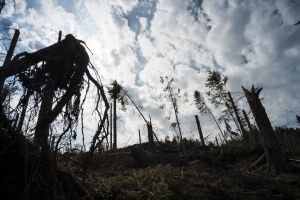Two new German-Chinese research groups will be established at KIT and partner institutions in China. Professor Stefan Hinz will head a group on space-borne remote sensing for prevention and forensic analysis of natural hazards and extreme events. Integrated catalytic technologies for efficient hydrogen production are in the focus of a research group headed by Professor Roland Dittmeyer. Both groups will be financed jointly by the Helmholtz Association and the Chinese Academy of Sciences (CAS).
The new funding program “Helmholtz-CAS Joint Research Groups” funds research projects of German and Chinese scientists for a period of up to three years with EUR 155,000 per year. Every team is funded with up to EUR 120,000 annually by the Helmholtz Association under its initiative and networking fund. CAS contributes up to EUR 35,000 annually. In the first round, five projects were selected for funding. KIT submitted two proposals, both of which will be funded.
The research group “Space-borne Microwave Remote Sensing for Prevention and Forensic Analysis of Natural Hazards and Extreme Events“ of Professor Stefan Hinz, Head of the Institute of Photogrammetry and Remote Sensing (IPF) of KIT, Professor Doris Dransch from the Helmholtz Centre Potsdam – German Research Centre for Geosciences (GFZ) – as well as Professor Yun Kai Deng and Professor Robert Yu Wang from the Institute of Electronics, Beijing, is aimed at enhancing the use of the potentials of space-borne remote sensing for natural hazards and extreme events. This technology allows for a highly precise image data acquisition irrespective of weather and illumination conditions. To improve efficiency of data evaluation and interpretation, the researchers pursue the interdisciplinary approach of “visual analytics” combining automatic data analysis with manual interpretation. The project is closely related to the work of CEDIM (Center for Disaster Management and Risk Reduction Technology) that is run jointly by KIT and GFZ.
The research group “Integrated Catalytic Technologies for Efficient Hydrogen Production“ focuses on an energy-efficient and inexpensive system for hydrogen production by means of membrane technology. This group is headed by Professor Roland Dittmeyer, Head of the Institute for Micro Process Engineering (IMVT) of KIT, and Professor Jan-Dierk Grunwaldt from the Institute of Catalysis Research and Technology (IKFT) of KIT as well as by Professor Andreas Goldbach from the Dalian National Laboratory for Clean Energy of the Dalian Institute of Chemical Physics (DICP) and Professor Xiulian Pan from State Key Laboratory of Catalysis of DICP. Central activities are the development of new nanostructured catalysts and ultra-thin metal membranes and their integration in compact systems for energy-efficient decentralized hydrogen production. For this purpose, the scientists study the integration of thin-film membranes and printed catalyst layers in compact multi-functional microreactors of high heat transfer efficiency. By means of synchrotron-based in situ spectroscopy, the scientists are given detailed insights into the structure of catalysts and membranes under reaction conditions in the microreactor.
The Helmholtz-CAS Joint Research Groups are aimed at strengthening German research by attracting excellent cooperation partners. The groups selected deal with important issues in the research areas of energy, earth and environment, health, key technologies, and structure of matter.
In close partnership with society, KIT develops solutions for urgent challenges – from climate change, energy transition and sustainable use of natural resources to artificial intelligence, sovereignty and an aging population. As The University in the Helmholtz Association, KIT unites scientific excellence from insight to application-driven research under one roof – and is thus in a unique position to drive this transformation. As a University of Excellence, KIT offers its more than 10,000 employees and 22,800 students outstanding opportunities to shape a sustainable and resilient future. KIT – Science for Impact.

